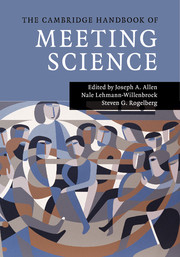Book contents
- The Cambridge Handbook of Meeting Science
- The Cambridge Handbook of Meeting Science
- Copyright page
- Dedication
- Contents
- Tables
- Figures
- Contributors
- Book part
- Part I Introduction
- Part II Premeeting Activities and Context
- Part III The Meeting Itself
- Capturing and Understanding Dynamics and Processes of the Meeting
- Tools and Models for Promoting Meeting Success
- 21 Designing and Executing Effective Meetings with Codified Best Facilitation Practices
- 22 Finding the Gorilla
- 23 Information Utilization in Meetings
- 24 What Is Consensus and How Is It Achieved in Meetings?
- 25 Creativity and Meetings
- Part IV Special Types of Meetings
- Part V Synthesis and Conclusion
- Book part
- Author Index
- Subject Index
- References
24 - What Is Consensus and How Is It Achieved in Meetings?
Four Types of Consensus Decision Making
from Tools and Models for Promoting Meeting Success
Published online by Cambridge University Press: 05 August 2015
- The Cambridge Handbook of Meeting Science
- The Cambridge Handbook of Meeting Science
- Copyright page
- Dedication
- Contents
- Tables
- Figures
- Contributors
- Book part
- Part I Introduction
- Part II Premeeting Activities and Context
- Part III The Meeting Itself
- Capturing and Understanding Dynamics and Processes of the Meeting
- Tools and Models for Promoting Meeting Success
- 21 Designing and Executing Effective Meetings with Codified Best Facilitation Practices
- 22 Finding the Gorilla
- 23 Information Utilization in Meetings
- 24 What Is Consensus and How Is It Achieved in Meetings?
- 25 Creativity and Meetings
- Part IV Special Types of Meetings
- Part V Synthesis and Conclusion
- Book part
- Author Index
- Subject Index
- References
Summary
This chapter makes three central claims: first, that the term “consensus” has been used to identify two different phenomena, mental consensus and interactional consensus; second, that unanimity (everyone agrees) and consensus (no one disagrees) are two distinct modes of collective decision-making; and third, that consensus is a mode of decision making that can be practiced in different ways, thus making it necessary to distinguish among four types of consensus when analyzing (and practicing) consensus decision making: imposed consensus, acclaimed consensus, basic consensus, and deliberative consensus. These types of consensus vary in their degree of openness toward dissenting voices.
- Type
- Chapter
- Information
- The Cambridge Handbook of Meeting Science , pp. 556 - 584Publisher: Cambridge University PressPrint publication year: 2015
References
- 10
- Cited by

